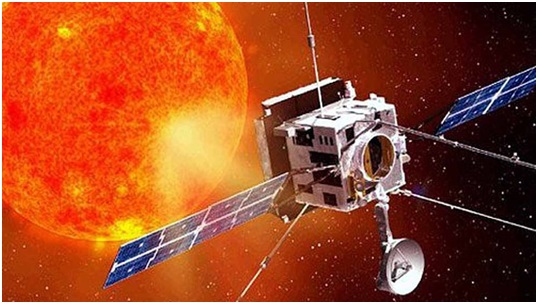Aditya-L1 (Indian Express)

- 29 Aug 2023
Why in the News?
The Aditya-L1 mission will launch on September 2 from Sriharikota, according to ISRO. The first Indian observatory in space, Aditya L1, will study the Sun.
What is the Aditya-L1 Mission?
Aditya, which in Sanskrit means "Sun," is a coronagraphy spacecraft that is intended to research the solar atmosphere, or solar corona, which is its outermost region. It was created by ISRO and several other Indian scientific organizations. It will be launched on a PSLV-XL launch vehicle and is the first specifically designed Indian mission to view the Sun.
Objectives of Aditya-L1 Mission:
- The Aditya L1 payloads' suits are anticipated to deliver vital data for comprehending the phenomenon of:
- The dynamics of space weather, particle and field propagation.
- Coronal mass ejection (CME), pre-flare and flare activities and their features, etc.
- The position of the spacecraft:
- The spacecraft will be positioned in a halo orbit around the Sun-Earth system's Lagrange point 1 (L1), according to ISRO.
- The main benefit of having a satellite in the halo orbit around the L1 point is being able to continuously see the Sun without any occultation or eclipses.
- This will provide us a better opportunity to watch the solar activity and how it affects the space weather in real time.
- 1.5 million kilometers separate L1 from the planet. The spacecraft is anticipated to take more than 120 days to arrive to L1.
- Study conducted by Aditya L1
- The photosphere, the lowest layer of the sun that we can see directly, the chromosphere, the layer 400–2,100 km above the photosphere, and the outermost layers of the sun (the corona), are the three layers that the spacecraft is equipped to observe.
- The remaining three playloads will examine particles and fields in situ at the Lagrange point L1, while the final four playloads will directly research the Sun.
- Remote sensing payloads that will study the sun include:
- The Visible Emission Line Coronagraph (VELC) for corona/imaging and spectroscopy and CME;
- The Solar Ultraviolet Imaging Telescope (SUIT) for photosphere and chromosphere imaging;
- The Solar Low Energy X-ray Spectrometer (SoLEXS), a soft X-ray spectrometer for Sun-as-a-star observation; and
- The High Energy L1 Orbit
- The payloads used to study the L1 in situ Aditya Solar Wind Particle Experiment (ASPEX) for solar wind/particle analyzer protons and heavier ions with directions;
- Plasma Analyser Package For Aditya (PAPA) for solar wind/particle analyzer electrons and heavier ions with directions; and
- Advanced Tri-axial High Resolution Digital Magnetometers for in situ magnetic field study.
Why is it necessary to study the Sun?
- Every planet, including Earth and the exoplanets outside the Solar System, evolves — and the parent star governs this evolution.
- The weather of the entire system is influenced by the solar weather and environment.
- Variations in this weather can cause satellites' orbits to shift or their lives to be cut short, interfere with or damage onboard electronics, and cause power outages and other disruptions on Earth.
- Understanding space weather requires knowledge of solar occurrences.
- Continuous solar observations are required to learn about, track, and anticipate the impact of Earth-directed storms.
- Every storm that forms in the Sun and travels to Earth passes through L1.
What is the first Lagrange point?
- A Lagrange point is a place in space where the gravitational attraction of two enormous masses exactly equals the centripetal force necessary to move with them.
- That is, at that moment, the gravitational attraction and repulsion between two celestial entities is such that an object put between them effectively stays in the same relative position while travelling with them.
- These spots in space can be employed by spacecraft to lower the amount of fuel required to stay in position.
- The five Lagrange points are named after the Italian-French mathematician Josephy-Louis Lagrange: L1, L2, L3, L4, and L5.
- The Earth-Sun system's L1 point provides an unobstructed view of the Sun.
- The Solar and Heliospheric Observatory Satellite SOHO is currently based there.
- The James Webb Space Telescope of NASA is at L2.
Other Solar Missions by Different Countries:
- United States
- Parker Solar Probe (August 2018): Touched the Sun’s upper atmosphere, sampled particles and magnetic fields in December 2021
- Solar Orbiter (February 2020): Explores the Sun’s changing space environment
- Europe
- Ulysses (October 1990): Studied space environment above and below the Sun’s poles
- Proba-2 (October 2001): Part of solar exploratory missions.
- Upcoming: Proba-3 (2024), Smile (2025)
- China
- Advanced Space-based Solar Observatory (ASO-S, October 2022): Launched to observe the Sun.
- Japan
- Hinotori (ASTRO-A, 1981): Studied solar flares using hard X-rays
- Yohkoh (SOLAR-A, 1991): Studied solar activity
- Hinode (SOLAR-B, 2006): Studied the Sun’s impact on Earth.
